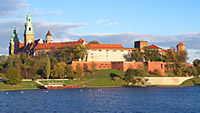
Wawel
chakram
Don’t expect a crowd of devotees of
the occult Wawel ‘chakra’
gathering on the splendid courtyard of the
Krakow Royal Castle
where the mysterious object is supposed to radiate its
beneficial powers. Yet an observant visitor may often notice an
individual or two (or more) who seem to idle for hours in the
north-east arcade. In the past people used to lean against the
wall of the western wing of the Renaissance castle directly
above the basement spaces believed to contain the ‘Wawel
chakram’. Now that fragment of the wall is fenced-off, sort
of, with a warning notice posted. So the believers only touch
the wall or just stand possibly close by to absorb the good
cosmic energy that allegedly emanates from the chakra.
What is the
Wawel chakra?
Its other Polish name
kamien wawelski
translates as a ‘Wawel
stone’ which suggests something solid. But neither the actual
form nor the substance of the Wawel chakra have been definitely
established. Some maintain it really is a stone placed in the
foundations of the Wawel Castle. Other self-styled experts
speculate that it may be some other material object. And the
most sophisticated propose subtler concepts such as a whirl of
energy or a concentration of power or an invisible tunnel to
something. Anyway, despite efforts no evidence of any physical
phenomenon have been found. So, evidently, the nature of the
Wawel stone is purely spiritual, paranormal, and transcendental.
The theory
behind the Wawel chakra.
There is an assumption that the
Earth has seven special places quite like ‘force centers’ of the
human body called chakras in the tantric and yogic teachings of
Hinduism.
Krakow, and specifically the Wawel Hill, is supposed
to be one of those holy areas. Also Rome, Jerusalem, and Delhi
are routinely awarded the same status. No consensus as regards
the remaining three places on the list.
How it all started.
The origins of the tale have been
traced to a newspaper story published in the mid-1930s. It
reported that two mysterious gentlemen from India visited the
Wawel Castle and were overly interested in an empty corner of the
courtyard, which prompted guesswork. The story resurfaced in the
1980s. Soon the Wawel chakra (called czakram in Polish) has
become famous in Krakow and Poland, its legend fanned by New Age
fads. In the 21st century it began to wane. Recently such
authorities as the Wawel museum management and the church has
engaged in battling the chakram fallacy which may breathe new
life into it.
|
Krakow in Poland
Wawel Hill
Wawel Hill in Krakow, the mecca of every Pole and a
must for foreign tourists, is a microcosm of Polish history
and culture.
Wawel Cathedral
Poland's impressive national shrine shelters plenty of
superb church art.
Wawel Royal Castle
Home to three dynasties of Poland's monarchs. Its
stately halls and exquisite chambers are filled with priceless
art, best period furniture and rare ancient objects. The
collection of the 16th-century monumental Flemish tapestries is
matchless.
Arrases
The matchless collection of 16th-century monumental
Flemish tapestries.
Crown
Treasury and Armory
The Crown Treasury shows Polish royal memorabilia, jewels and
other precious items. The adjacent Armory displays 15th to
18th-century arms.
Dragon's Den
Huge natural cavity inside the Wawel Hill is the
legendary home of a legendary monster.
|



